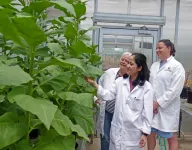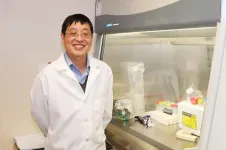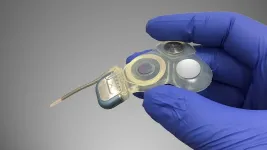(Press-News.org) A team of scientists have measured the relative importance of the different obstacles that carbon dioxide (CO2) encounters in its voyage from the atmosphere to the interior of plant cells, where it is converted into sugars. This research leading method provides much needed information that will help to increase the yield of important food crops such as cowpea, soybean and cassava.
"Our data highlights promising targets to improve the diffusion of CO2 through the leaf with the aim of boosting crop productivity," says lead author Dr Tory Clarke, who works at The Australian National University (ANU), as part of the Realizing Increased Photosynthetic Efficiency (RIPE) project, an international research project that aims to improve photosynthesis to equip farmers worldwide with higher-yielding crops.
CO2 moves into the plant cells and is transformed into food during photosynthesis by enzymes located inside the chloroplasts. However, this journey is not a smooth one but rather one full of obstacles and resistances such as solid walls, liquid valleys and tunnels guarded by gate-keeper proteins.
"Our results will help enormously in the creation of more precise leaf and crop models, as we have linked the anatomical structures inside the leaves with important physiological crop aspects, such as the age of the leaf and its position in the canopy, to find out what is influencing CO2 uptake into leaf cells," says Dr Clarke, from the ARC Centre of Excellence for Translational Photosynthesis (CoETP).
The paper, published this week in the Royal Society journal Interface Focus, used tobacco as a model because this plant forms a canopy like other important food crops, such as soybean, cowpea and potato.
"Our aim is to make these crops more productive, but we want to improve not only the leaves at the top of the canopy, but propagate these changes through the whole plant. In this paper, we consider the inherit leaf variation within the canopy and its relationship to photosynthetic capacity," says CoETP's Dr Florence Danila, co-author of the paper.
The diffusion of CO2 from the air into leaf cells is essential for photosynthesis, but until now, the understanding of how this occurs has been quite limited.
"In this study, we have fleshed out all these parameters and physiological measurements and found that variables such as the thickness of the cell walls should be a target for improvement in future studies," says CoETP's Deputy Director Professor Susanne von Caemmerer, one of the co-authors of this study.
"Surprisingly, other aspects such as the relationship between the chloroplast area and the position of the leaves in the canopy were not as relevant as we expected. This information is essential for future researchers focused on improving photosynthesis and food production in canopy crops," she says.
INFORMATION:
This work was carried out by researchers at ANU, as part of the ARC Centre of Excellence for Translational Photosynthesis (CoETP) and the Realizing Increased Photosynthetic Efficiency (RIPE) project. RIPE is sponsored by the Bill & Melinda Gates Foundation, the U.S. Foundation for Food & Agriculture Research, and the U.K. Foreign, Commonwealth & Development Office who are committed to ensuring Global Access and making the project's technologies available to the farmers who need them the most. The CoETP aims to improve the process of photosynthesis to increase the production of major food crops.
Psychologists at the University of Bath, Cardiff, and London have developed the first ever 'mind-reading questionnaire' to assess how well people understand what others are really thinking.
A new approach to 'mind-reading' has been developed by researchers at the University of Bath, Cardiff, and London to improve how well we understand what others are thinking. And it transpires that women are much better than men at putting themselves in someone else's shoes.
Mind-reading, sometimes referred to in psychology as 'mentalising', is an important ability enabling us to pick-up on subtle behavioural cues that might indicate that someone we are speaking to is thinking ...
A new modelling study published in Anaesthesia (a journal of the Association of Anaesthetists) shows that the UK's coronavirus vaccination program is already reducing daily deaths. However, reductions of hospital and intensive care (ICU) admissions will likely take several weeks longer, with large reductions seen by the end of March and continuing into April.
The study is by Professor Tim Cook (Consultant in Anaesthesia and Intensive Care Medicine, Royal United Hospitals Bath NHS Foundation Trust, Bath, UK, and Honorary Professor, School of Medicine, University of Bristol, UK) and Mr ...
Anti-retroviral drugs are a vital tool in the prevention and treatment of HIV. A new study of pregnant women in Tanzania shows that life-long antiviral treatment also seems to prevent viral transmission from mother to baby. The results of the study, which was conducted in part by researchers at Karolinska Institutet in Sweden and published in Lancet HIV, make a promising contribution to the WHO's work with HIV prevention in low and middle-income countries.
Just over eight years ago, the World Health Organisation (WHO) issued recommendations known as Option B+ for a simpler and more effective prevention and treatment for HIV during and beyond pregnancy in low and middle-income countries.
One arm of the Option B+ programme involved ensuring that pregnant women with HIV ...
Researchers from North Carolina State University used a three-model approach to trace the between-farm spread of porcine epidemic diarrhea virus (PEDV), as well as to analyze the efficacy of different control strategies in these scenarios. The approach may enable farmers to be more proactive in preventing the spread of PEDV and to optimize their efforts to control the disease.
PEDV is a virus that causes high mortality rates in preweaned piglets. The virus emerged in the U.S. in 2013 and by 2014 had infected approximately 50 percent of breeding herds. PEDV is transmitted by contact with contaminated fecal matter.
"We wanted to compare three different models by using actual outbreak data in order to test their efficacy," says Gustavo Machado, assistant professor of population ...
To build a universal quantum computer from fragile quantum components, effective implementation of quantum error correction (QEC) is an essential requirement and a central challenge. QEC is used in quantum computing, which has the potential to solve scientific problems beyond the scope of supercomputers, to protect quantum information from errors due to various noise.
Published by the journal Nature, research co-authored by University of Massachusetts Amherst physicist Chen Wang, graduate students Jeffrey Gertler and Shruti Shirol, and postdoctoral researcher Juliang Li takes a step toward building a fault-tolerant ...
New research from the Indiana University Kelley School of Business shows first evidence that watching and learning from others can help reduce bias and improve decision-making.
The research, published END ...
MUSC Hollings Cancer Center researcher Yongxia Wu, Ph.D., identified a new target molecule in the fight against graft-versus-host disease (GVHD). Bone marrow transplant, a treatment for certain blood cancers, is accompanied by potentially life-threatening GVHD in nearly 50% of patients. A January 2021 paper published in Cellular and Molecular Immunology revealed that activating a molecule called STING may be a new approach to reduce GVHD.
Xue-Zhong Yu, M.D., professor in the Department of Microbiology and Immunology, focuses on understanding the intricate immune mechanisms that regulate GVHD development and anti-tumor activity.
Recently, STING (stimulator of interferon genes) has been highly studied in the context of cancer. Data from other groups has shown that STING activation ...
Irvine, CA - February 11, 2021 - Subconsciously, our bodies keep time for us through an ancient means - the circadian clock. A new University of California, Irvine-led article reviews how the clock controls various aspects of homeostasis, and how organs coordinate their function over the course of a day.
"What is fascinating is that nearly every cell that makes up our organs has its own clock, and thus timing is a crucial aspect of biology," said Kevin B. Koronowski, PhD, lead author and a postdoctoral fellow in Biological Chemistry at the UCI School of Medicine. "Understanding how daily timing is integrated with function ...
A Russian physicist and his international colleagues studied a quantum point contact (QCP) between two conductors with external oscillating fields applied to the contact. They found that, for some types of contacts, an increase in the oscillation frequency above a critical value reduced the current to zero - a promising mechanism that can help create nanoelectronics components. This research supported by the Russian Science Foundation (RSF) was published in the Physical Review B journal.
A persistent trend in the modern electronics, miniaturization has spurred demand for new nano-sized devices that boast advanced performance and leverage quantum effects with electrons ...
Getting around without the need to concentrate on every step is something most of us can take for granted because our inner ears drive reflexes that make maintaining balance automatic. However, for about 1.8 million adults worldwide with bilateral vestibular hypofunction (BVH) -- loss of the inner ears' sense of balance -- walking requires constant attention to avoid a fall. Now, Johns Hopkins Medicine researchers have shown that they can facilitate walking, relieve dizziness and improve quality of life in patients with BVH by surgically implanting a stimulator that electrically ...







